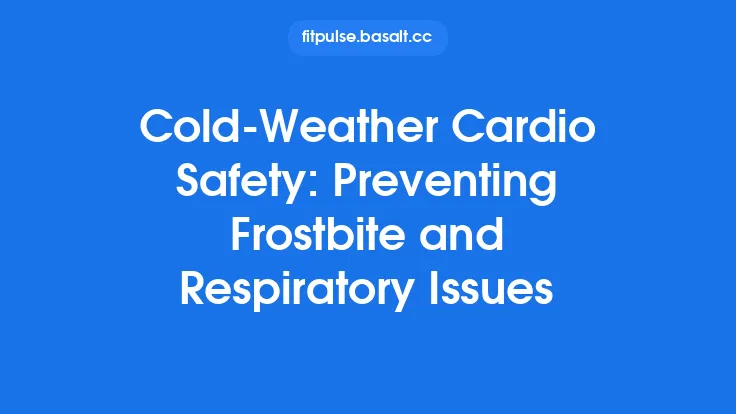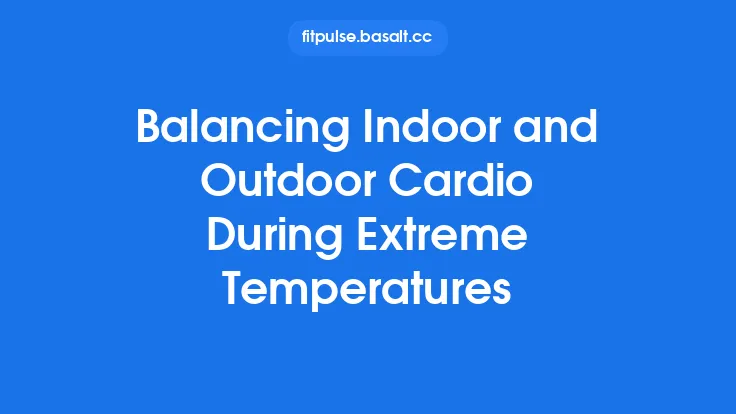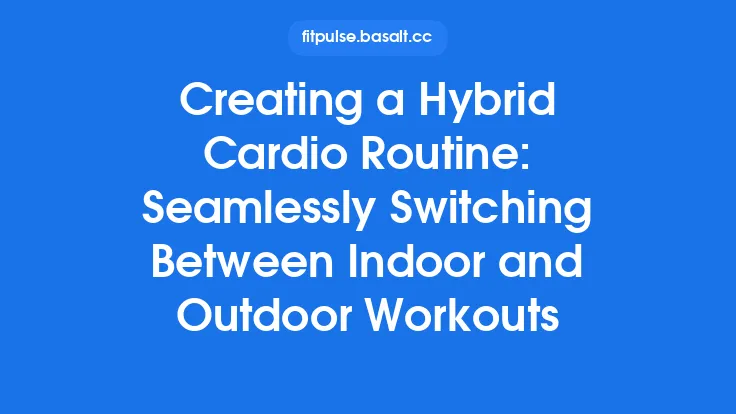Outdoor cardio is uniquely rewarding because it places the body in direct dialogue with the elements. The same run that feels invigorating on a crisp spring morning can become a physiological challenge when the temperature spikes, humidity climbs, or wind gusts turn the route into a resistance field. Understanding how weather interacts with the body’s cardiovascular and thermoregulatory systems—and having a toolbox of adaptation strategies—allows athletes to preserve performance, reduce injury risk, and keep training consistent year‑round.
Understanding Weather Variables and Their Physiological Effects
Weather is a composite of several measurable variables—temperature, humidity, wind speed, barometric pressure, and precipitation. Each influences the body’s ability to regulate core temperature, deliver oxygen to working muscles, and maintain cardiovascular stability. While the term “environmental factors” is often used broadly, this section isolates the weather components that most directly affect cardio performance and explains the underlying physiology.
- Core Temperature Regulation – The hypothalamus maintains a narrow core temperature window (~37 °C). When external temperature diverges from this set point, the body must either dissipate excess heat (via sweating and vasodilation) or conserve heat (through vasoconstriction and shivering). Both processes demand cardiovascular adjustments that can alter heart‑rate response, stroke volume, and perceived exertion.
- Cardiovascular Drift – In prolonged exercise under warm or humid conditions, heart rate gradually rises despite a constant workload. This “drift” reflects reduced stroke volume caused by plasma volume shifts to the skin for cooling, forcing the heart to pump faster to sustain cardiac output.
- Oxygen Delivery and Blood Viscosity – Cold exposure can increase blood viscosity, making it slightly harder for the heart to pump. Conversely, heat expands plasma volume, which can lower blood viscosity but also increase the demand for skin blood flow, diverting some circulation away from active muscles.
- Metabolic Cost of Wind – Headwinds increase the mechanical work required to maintain speed, raising oxygen consumption. Tailwinds have the opposite effect, allowing a runner to maintain pace with lower metabolic cost.
- Biomechanical Adjustments in Precipitation – Wet surfaces alter friction coefficients, prompting subtle changes in gait, stride length, and ground reaction forces. Snow adds an insulating layer that can trap heat but also increases the energy cost of moving through a pliable medium.
By recognizing these mechanisms, athletes can anticipate how a given weather profile will shift the internal load of a cardio session, even before stepping outside.
Temperature Extremes: Heat and Cold
Heat (Above ~20 °C / 68 °F)
- Thermoregulatory Load – Sweat production escalates to evaporate heat. Each gram of sweat removes roughly 0.58 kcal of heat, but the process also depletes electrolytes and plasma volume.
- Cardiovascular Redistribution – Up to 30 % of cardiac output may be diverted to the skin for cooling, reducing the proportion available for skeletal muscle. This can manifest as an earlier rise in heart rate at a given pace.
- Performance Implications – Studies consistently show a 1–2 % decrement in VO₂max for every 5 °C rise above thermoneutral conditions. The effect is amplified when humidity limits evaporative cooling.
Cold (Below ~5 °C / 41 °F)
- Peripheral Vasoconstriction – Blood flow to the extremities is reduced to preserve core heat, which can lead to a sensation of “cold limbs” and a slight increase in perceived effort.
- Shivering Thermogenesis – In very cold environments, involuntary muscle activity (shivering) can increase oxygen consumption by up to 100 % of resting metabolic rate, competing with the cardio workload.
- Respiratory Considerations – Cold, dry air can irritate the airway, leading to bronchoconstriction in susceptible individuals, which subtly raises the work of breathing.
Adaptation Strategies
- Heat – Schedule workouts during the coolest part of the day (early morning or late evening). Use a lightweight, moisture‑wicking base layer and a breathable outer shell that facilitates sweat evaporation. Incorporate short, high‑intensity intervals early in the session when plasma volume is still optimal, then transition to lower‑intensity steady‑state work as sweat loss accumulates.
- Cold – Layer strategically: a moisture‑wicking base, an insulating mid‑layer, and a wind‑proof outer shell. Pre‑warm the muscles with dynamic movements (leg swings, high knees) before the main effort. Consider a brief “warm‑up jog” of 5–10 minutes at a very easy pace to raise core temperature before increasing intensity.
Humidity and Its Interaction with Temperature
Relative humidity (RH) determines how effectively sweat can evaporate. The heat index (or “feels‑like” temperature) combines ambient temperature and RH to estimate the thermal stress on the body.
- High Humidity (>70 % RH) – Evaporation slows, reducing the cooling efficiency of sweat. The body compensates by increasing sweat rate, which can accelerate dehydration and electrolyte loss.
- Low Humidity (<30 % RH) – Evaporation is rapid, which can lead to excessive fluid loss and a higher risk of exercise‑associated hyponatremia if fluid intake is not matched to sweat loss.
Adaptation Strategies
- Pre‑Exercise Hydration Planning – Use a sweat‑rate test (weigh before and after a 1‑hour run in typical conditions) to calculate personal fluid loss per hour. Adjust fluid intake accordingly, adding electrolytes when humidity is high.
- Clothing Choices – In humid heat, opt for garments with high moisture‑transport capacity (e.g., polyester blends with engineered wicking). In dry heat, a slightly more insulated fabric can prevent rapid skin cooling after the workout.
- Pacing Adjustments – When the heat index exceeds 32 °C (90 °F), consider reducing target pace by 5–10 % to keep heart‑rate zones within a manageable range, thereby limiting cardiovascular drift.
Wind and Its Influence on Perceived Effort
Wind speed and direction directly affect the aerodynamic drag experienced during running or cycling. Drag force (F_d) can be expressed as:
\[
Fd = \frac{1}{2} \cdot Cd \cdot A \cdot \rho \cdot v^2
\]
where C_d is the drag coefficient, A the frontal area, ρ the air density, and v the relative wind speed. Because drag scales with the square of wind speed, even modest breezes can noticeably increase energy cost.
- Headwinds – Increase oxygen consumption by 5–15 % at 10–15 km/h (6–9 mph) for most runners.
- Crosswinds – Can destabilize gait, especially on uneven terrain, leading to subtle changes in stride mechanics that may increase muscular fatigue.
- Tailwinds – Reduce metabolic cost, but can also encourage an unsustainable pace if the athlete does not adjust effort perception.
Adaptation Strategies
- Route Selection – Choose courses with natural windbreaks (trees, buildings) on windy days, or reverse direction on the return leg to convert a headwind into a tailwind.
- Aerodynamic Positioning – For cyclists, adopt a more streamlined posture (lower torso angle, narrow elbows) when facing a headwind. Runners can slightly lean forward from the ankles to reduce frontal area.
- Effort‑Based Pacing – Instead of relying on speed, use heart‑rate zones or perceived exertion (RPE) to maintain consistent internal load regardless of wind conditions.
Precipitation: Rain, Snow, and Their Impact on Biomechanics
Rain
- Surface Slippage – Wet pavement reduces friction, increasing the risk of a slip. From a biomechanical standpoint, the body may instinctively shorten stride length and increase cadence to maintain stability, which can raise the metabolic cost of running.
- Thermal Conductivity – Water conducts heat away from the body ~25 times faster than air, accelerating core temperature loss, especially in cooler climates.
Snow
- Increased Ground Compliance – Soft snow absorbs more energy with each footfall, requiring greater muscular effort to push off. Studies show a 10–15 % rise in oxygen consumption when running on fresh snow compared to a firm surface.
- Insulation Effect – Snow can act as an insulating layer, trapping body heat, but this is offset by the extra effort needed to move through a pliable medium.
Adaptation Strategies
- Footwear Selection – Use shoes with aggressive tread patterns for rain or snow to improve traction. Consider waterproof or water‑resistant uppers to keep feet dry, which helps maintain foot temperature.
- Layering for Wet Conditions – A lightweight, water‑repellent outer shell (e.g., Gore‑Tex®) prevents rain from soaking the base layer, preserving the insulating properties of the inner garment.
- Technique Adjustments – In snow, shorten the stride and increase cadence to reduce the time each foot spends sinking into the surface. In rain, focus on a mid‑foot strike to improve stability on slick terrain.
Monitoring Weather Data for Informed Decision‑Making
Relying on intuition alone can lead to suboptimal training choices. Modern weather services provide granular data that can be integrated into a cardio planning workflow.
| Parameter | Typical Source | Practical Use |
|---|---|---|
| Temperature (°C/°F) | Local meteorological stations, smartphone apps | Set core‑temperature expectations, choose appropriate clothing |
| Relative Humidity | Same as above | Calculate heat index, adjust fluid strategy |
| Wind Speed & Direction | NOAA, Windy.com, local airport METARs | Plan route orientation, anticipate aerodynamic load |
| Precipitation Probability | Radar maps, hourly forecasts | Decide on waterproof gear or indoor backup |
| UV Index | Weather apps, EPA website | Schedule sunscreen application, protect skin |
Implementation Tips
- Morning Check‑In – Review the forecast 30 minutes before heading out. If the heat index is projected to exceed your personal threshold (e.g., 30 °C / 86 °F), consider a shorter, higher‑intensity session or shift to a cooler time slot.
- Real‑Time Alerts – Enable push notifications for sudden weather changes (e.g., thunderstorms) to allow rapid transition to a safe indoor environment.
- Historical Data Review – Keep a training log that records weather conditions alongside performance metrics (pace, heart rate). Over time, patterns emerge that help fine‑tune your adaptation strategies.
Clothing and Gear Strategies for Different Conditions
The right apparel acts as a “second skin,” facilitating thermoregulation while minimizing drag and moisture buildup.
| Condition | Base Layer | Mid Layer | Outer Layer | Accessories |
|---|---|---|---|---|
| Hot, Dry | Light, moisture‑wicking (e.g., polyester) | None or ultra‑light mesh | Breathable, vented (e.g., mesh) | UV‑blocking cap, sunglasses |
| Hot, Humid | Same as hot, dry | Optional thin fleece for early morning | Water‑resistant, breathable (e.g., DWR‑treated) | Sweat‑wicking headband |
| Cool, Dry | Merino wool or synthetic wicking | Light fleece or insulated jacket | Wind‑proof, breathable shell | Gloves, beanie |
| Cool, Wet | Moisture‑wicking synthetic | Insulating fleece | Waterproof, breathable (e.g., Gore‑Tex) | Waterproof hat, gaiters |
| Snow | Thermal wicking | Heavy fleece or down | Fully waterproof, insulated shell | Neck gaiter, insulated gloves, traction devices (e.g., Yaktrax) |
Technical Considerations
- Fabric Moisture Vapor Transmission Rate (MVTR) – Higher MVTR values (g / m² / day) indicate better breathability. For hot, humid conditions, aim for MVTR > 10,000.
- Thermal Conductivity (k‑value) – Lower k‑values mean better insulation. In cold environments, select fabrics with k < 0.04 W/m·K.
- Seam Construction – Flat‑lock seams reduce chafing and prevent water ingress at stress points.
Adjusting Training Variables to Weather
When the environment changes, the same external workload can represent a different internal stimulus. The three primary training variables—intensity, duration, and volume—can be modulated to keep the physiological load within target zones.
- Intensity (Heart‑Rate Zones / Power Output)
- In heat, aim for the lower end of Zone 2 (60‑70 % HRmax) for longer sessions; reserve Zone 4‑5 intervals for cooler periods of the day.
- In cold, you may maintain typical intensity but monitor for premature fatigue due to reduced muscle temperature.
- Duration
- Reduce total time by 10‑20 % when the heat index exceeds 35 °C (95 °F) to limit cumulative cardiovascular drift.
- In snowy conditions, consider shorter, higher‑cadence intervals to offset the added mechanical work of moving through soft terrain.
- Volume (Weekly Mileage/Hours)
- Use a “weather‑adjusted load calculator”:
\[
\text{Adjusted Load} = \text{Planned Load} \times \left(1 + \frac{\Delta T}{30}\right)
\]
where ΔT is the deviation from thermoneutral temperature (≈20 °C). Positive ΔT (heat) increases load factor; negative ΔT (cold) slightly decreases it.
Practical Example
A runner plans a 10 km steady‑state run at 75 % HRmax. On a day with a heat index of 38 °C, the adjusted load factor is 1 + (18/30) ≈ 1.6. To keep the internal load comparable to a thermoneutral day, the runner could:
- Reduce distance to ~6 km, or
- Lower intensity to 65 % HRmax while keeping the 10 km distance.
Hydration and Nutrition Strategies Tailored to Climate
Heat
- Pre‑Exercise – Ingest 5–7 ml kg⁻¹ of water 2 hours before the session, plus 200–300 ml of a carbohydrate‑electrolyte solution 15 minutes prior.
- During Exercise – Aim for 150–250 ml h⁻¹ of fluid, adjusting upward if sweat rate exceeds 1 L h⁻¹. Include sodium (≥ 500 mg L⁻¹) to maintain plasma osmolality.
- Post‑Exercise – Replace 150 % of fluid lost (weigh before/after) and consume a 3:1 carbohydrate‑protein snack within 30 minutes.
Cold
- Pre‑Exercise – Hydration needs are lower because sweat loss is reduced, but a baseline of 250–300 ml of water 30 minutes before is still advisable.
- During Exercise – Even in cold, aim for 100–150 ml h⁻¹ to offset insensible water loss through respiration. Warm fluids (e.g., tea) can help maintain core temperature.
- Post‑Exercise – Rehydrate to baseline body weight; consider a warm, carbohydrate‑rich meal to aid glycogen restoration and thermogenesis.
Nutrient Timing
- Electrolyte Timing – Sodium and potassium intake should be spread throughout the session rather than delivered all at once, to improve absorption and reduce gastrointestinal distress.
- Carbohydrate Periodization – In hot, long‑duration sessions (> 90 minutes), aim for 30–60 g h⁻¹ of carbohydrate; in cold, 20–30 g h⁻¹ is sufficient because glycolytic demand is slightly lower.
Periodization and Seasonal Planning for Consistent Progress
A well‑structured macrocycle acknowledges the predictable shifts in weather across the year and builds “weather‑specific blocks” into the training plan.
- Base Phase (Cooler Months) – Emphasize higher mileage at moderate intensity, taking advantage of lower thermal strain to develop aerobic capacity. Incorporate occasional “heat‑tolerance” sessions (short, controlled runs in a warm indoor environment) to prime the body for upcoming summer months.
- Build Phase (Transition Months) – Gradually introduce heat‑acclimation workouts: start with 10‑minute intervals at 70 % HRmax in temperatures 2–3 °C above baseline, extending duration weekly. Simultaneously, maintain strength work to counteract the loss of muscle power that can accompany prolonged heat exposure.
- Peak Phase (Summer) – Schedule key performance workouts during the coolest daily windows, but also include “simulated race conditions” where the athlete deliberately trains at target race temperature and humidity. Use heart‑rate drift monitoring to fine‑tune pacing strategies.
- Recovery/Taper (Fall) – As temperatures drop, shift focus back to volume, allowing the body to recover from the cumulative heat load while preserving fitness gains.
- Off‑Season (Winter) – Leverage the cold to emphasize strength and cross‑training, while still maintaining a minimal cardio stimulus (e.g., 2–3 low‑intensity runs per week).
Key Planning Tools
- Weather‑Adjusted Training Load Spreadsheet – Input forecasted temperature, humidity, and wind for each planned session; the sheet automatically calculates adjusted intensity and duration recommendations.
- Acclimation Log – Track core temperature (via ingestible thermistor pills or skin sensors), heart‑rate drift, and perceived exertion across successive heat sessions to quantify adaptation progress.
Leveraging Technology for Real‑Time Adaptation
Modern wearables and mobile apps can close the feedback loop between external conditions and internal response.
- Smart Thermometers & Skin Sensors – Devices like the Garmin HRM‑Pro or Polar H10 paired with skin temperature patches provide continuous core‑temperature estimates. When a preset threshold (e.g., 38 °C) is crossed, the device can trigger a vibration alert, prompting the athlete to reduce intensity or seek shade.
- Dynamic Pace Adjusters – Some GPS watches integrate real‑time weather data (via Bluetooth to a phone) and automatically adjust target pace zones based on heat index.
- Sweat‑Rate Analytics – Apps such as HydraCoach use weight‑change inputs and ambient humidity to estimate sweat loss, then generate personalized fluid‑intake recommendations on the fly.
- Wind‑Compensated Power Meters – For cyclists, power meters that factor in wind speed (e.g., SRM PowerTap) allow the rider to maintain a consistent power output regardless of headwind or tailwind, preserving training intensity.
Implementation Checklist
- Sync Devices – Ensure your smartwatch, heart‑rate strap, and phone are paired and have the latest weather‑integration firmware.
- Set Thresholds – Define personal limits for core temperature, heart‑rate drift (e.g., > 10 bpm increase over 10 minutes), and humidity‑adjusted sweat loss.
- Test in Controlled Conditions – Run a short session in a climate‑controlled environment to calibrate sensor accuracy before relying on them outdoors.
- Review Post‑Session Data – Analyze the correlation between weather variables and performance metrics to refine future adaptation strategies.
When to Transition to Indoor Sessions
Even the most thorough adaptation plan acknowledges that extreme weather—such as heat waves exceeding 40 °C (104 °F) with high humidity, or severe winter storms—can compromise training quality and health. In those cases, a brief indoor cardio session (treadmill, stationary bike, or rowing machine) can preserve weekly volume without exposing the athlete to dangerous conditions. The key is to match the indoor intensity to the intended outdoor stimulus, using heart‑rate zones or power targets rather than simply substituting a “fallback” workout.
Summary
Weather is an ever‑present variable that reshapes the physiological demands of outdoor cardio. By dissecting how temperature, humidity, wind, and precipitation each influence thermoregulation, cardiovascular drift, and biomechanics, athletes gain a scientific foundation for adaptation. Practical tools—ranging from precise clothing systems and hydration protocols to data‑driven training‑load adjustments and wearable technology—enable runners and cyclists to stay on target regardless of the forecast. Integrating weather‑aware periodization ensures that seasonal shifts become a strategic asset rather than an obstacle, fostering consistent progress and long‑term resilience in cardiovascular conditioning.





